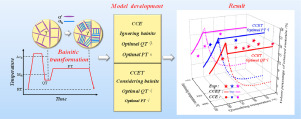当前位置:
X-MOL 学术
›
Acta Mater.
›
论文详情
Our official English website, www.x-mol.net, welcomes your
feedback! (Note: you will need to create a separate account there.)
Modeling retained austenite in Q&P steels accounting for the bainitic transformation and correction of its mismatch on optimal conditions
Acta Materialia ( IF 8.3 ) Pub Date : 2020-04-01 , DOI: 10.1016/j.actamat.2020.02.033 Yong Li , Shan Chen , Chenchong Wang , David San Martín , Wei Xu
Acta Materialia ( IF 8.3 ) Pub Date : 2020-04-01 , DOI: 10.1016/j.actamat.2020.02.033 Yong Li , Shan Chen , Chenchong Wang , David San Martín , Wei Xu

|
Abstract Modeling retained austenite in quenching and partitioning (Q&P) steels remains a challenge, and the conventional ‘constrained carbon equilibrium’ (CCE) model fails to predict the optimal condition for achieving the maximal amount of retained austenite in various systems, which impedes the optimization of the Q&P process. One of the main limitations is that the possible decomposition of austenite to bainite during partitioning is completely ignored by the essential assumptions of the Q&P process and hence the associated CCE model. In this study, a CCET model that combines the conventional CCE model with the T0 model for the bainitic transformation and incorporates the effect of the isothermal bainitic transformation to describe the austenite stability during the Q&P process has been proposed. A detailed comparison between the experimental observation and model predictions demonstrated that the retained austenite could be better described by the CCET model, including its carbon content. The current model therefore provides a more accurate approach for tailoring the amount and stability of retained austenite after the Q&P processing of Fe-C-Mn-Si steels.
中文翻译:

建模 Q&P 钢中的残余奥氏体,考虑贝氏体转变并在最佳条件下纠正其失配
摘要 对淬火和分配 (Q&P) 钢中的残余奥氏体进行建模仍然是一个挑战,传统的“约束碳平衡”(CCE) 模型无法预测在各种系统中实现最大残余奥氏体量的最佳条件,这阻碍了优化的 Q&P 过程。主要限制之一是,Q&P 过程的基本假设以及相关的 CCE 模型完全忽略了分配过程中奥氏体可能分解为贝氏体的可能性。在本研究中,提出了一种 CCET 模型,该模型将常规 CCE 模型与贝氏体转变的 T0 模型相结合,并结合等温贝氏体转变的影响来描述 Q&P 过程中的奥氏体稳定性。实验观察和模型预测之间的详细比较表明,CCET 模型可以更好地描述残留奥氏体,包括其碳含量。因此,当前模型提供了一种更准确的方法来调整 Fe-C-Mn-Si 钢 Q&P 处理后残余奥氏体的数量和稳定性。
更新日期:2020-04-01
中文翻译:

建模 Q&P 钢中的残余奥氏体,考虑贝氏体转变并在最佳条件下纠正其失配
摘要 对淬火和分配 (Q&P) 钢中的残余奥氏体进行建模仍然是一个挑战,传统的“约束碳平衡”(CCE) 模型无法预测在各种系统中实现最大残余奥氏体量的最佳条件,这阻碍了优化的 Q&P 过程。主要限制之一是,Q&P 过程的基本假设以及相关的 CCE 模型完全忽略了分配过程中奥氏体可能分解为贝氏体的可能性。在本研究中,提出了一种 CCET 模型,该模型将常规 CCE 模型与贝氏体转变的 T0 模型相结合,并结合等温贝氏体转变的影响来描述 Q&P 过程中的奥氏体稳定性。实验观察和模型预测之间的详细比较表明,CCET 模型可以更好地描述残留奥氏体,包括其碳含量。因此,当前模型提供了一种更准确的方法来调整 Fe-C-Mn-Si 钢 Q&P 处理后残余奥氏体的数量和稳定性。









































 京公网安备 11010802027423号
京公网安备 11010802027423号